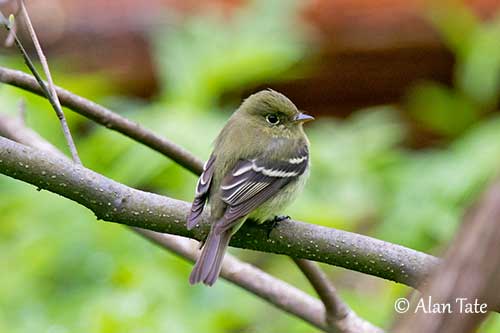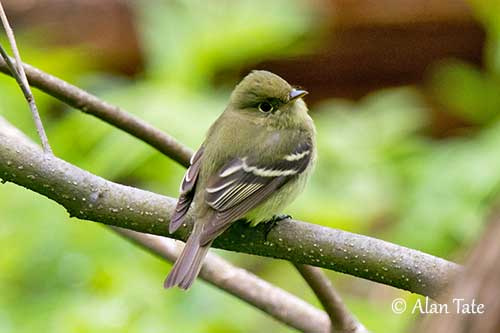
During the breeding season, the male sings from perch 3-10 metres up to defend the territory. The nest-site is selected by the female and she builds the nest in well-concealed site at ground level.
They are apparently monogamous and the pair forms soon after arrival on the breeding grounds. The male performs a flight-song during courtship and pair formation period. Copulation is frequent during this period. Both mates touch their bills during the copulation.
The Yellow-bellied Flycatcher is a long-distance migrant and moves southwards after breeding to spend the winter in Central America. It migrates at night. It leaves the breeding areas in late August to late September, and returns to north from March to mid-May. Vagrants are reported from W North America and Greenland.
The Yellow-bellied Flycatcher has weak, fluttering flight with shallow, rapid wingbeats.
REPRODUCTION OF THIS SPECIES:
The laying takes place between late May and early August.
The female selects a nest-site and builds the nest on or just above the ground. The site is often in boggy habitat and the nest is usually well-concealed, sometimes placed in dense sphagnum moss or among upturned roots of fallen tree, and other sheltered, low places.
The bulky cup-shaped structure is made of moss mixed with weeds and rootlets. The cup is lined with softer grass, sedges and many fine rootlets. It is well-hidden within mosses and only a small entrance is visible.
The female lays 3-5 white eggs with light brown spots at large end. She incubates alone during 12-14 days. At hatching, the chicks are naked and their eyes are closed. The male feeds the female away from the nest, and then, she feeds the chicks. The young fledge about 13-14 days after hatching.
If the pair produces a second brood, the male feeds the first chicks while the female builds a new nest and incubates the eggs. She is fed by the male away from the nest.
PROTECTION / THREATS / STATUS:
The Yellow-bellied Flycatcher is described as fairly common, but its breeding habitat is not easily accessible. The species is affected by habitat loss through loss of forest for agriculture expansion on the wintering grounds.
The global population is estimated to number 6,200,000 individuals but more study is required.
The species is common in continuous habitat in Canada, and one of the most common species in Newfoundland. It is probably less secure in more fragmented range in NE USA, caused by reduction of suitable habitat.
However, the Yellow-bellied Flycatcher is not considered globally threatened, and the species is currently evaluated as Least Concern.
Fr: Moucherolle à ventre jaune
Ang: Yellow-bellied Flycatcher
All: Birkenschnäppertyrann
Esp: Mosquero Ventriamarillo
Ita: Pigliamosche panciagialla
Nd: Berkenfeetiran
Sd: gulbukig empid
Photographers:
Alan & Ann Tate
AA Bird Photography
Text by Nicole Bouglouan
Sources:
HANDBOOK OF THE BIRDS OF THE WORLD Vol 9 - by Josep del Hoyo - Andrew Elliot - David Christie - Lynx Edicions - ISBN: 8487334695
Animal Diversity Web (University of Michigan Museum of Zoology)
Houston Audubon Society (National Audubon Society)
Tennessee Wildlife Resources Agency
South Dakota Birds and Birding – (Terry L. Sohl)
What Bird-The ultimate Bird Guide (Mitchell Waite)
Wikipedia, the free encyclopaedia
Yellow-bellied Flycatcher
Empidonax flaviventris
Passeriformes Order – Tyrannidae Family
INTRODUCTION:
The members of the genus Empidonax show fairly similar structure and plumage pattern, but the differentiation occurs mainly through voice and behaviour. These birds are always difficult to identify.
There are differences also in habitat, nesting habits and distribution between birds with almost similar plumage characteristics.
Numerous Empidonax species are widespread in North and Middle America. Some of them have more restricted range.
The Yellow-bellied Flycatcher is very similar to other Empidonax species and its identification is often difficult. However, most species are best identified by song.
The Yellow-bellied Flycatcher is a small, compact bird with relatively large head. It breeds across northern North America, from C Alaska to Newfoundland, and moves after breeding through E USA to reach S Mexico and Central America.
It frequents coniferous forests, swamps and bogs when breeding, whereas in winter, it is mainly found in dense rainforest, mixed pine-oak forests and coffee plantations. It feeds on small insects and spiders, and also takes berries and seeds in small numbers outside of breeding season. It nests on or near the ground in boggy areas. The nesting duties are more or less shared by both adults.
The Yellow-bellied Flycatcher is affected by habitat loss in the winter range, but currently, the species is not globally threatened.

DESCRIPTION OF THE BIRD:
Biometrics:
Length: 13-15 cm
Wingspan: 18-20 cm
Weight: 9-16 g
The Yellow-bellied Flycatcher is a small to medium-sized flycatcher. The tail is short but the wings are fairly long.
The upperparts are uniformly olive-green, but the head is usually darker. On the upperwing, primary and secondary flight-feathers are dark brown to blackish with pale edges. They contrast strongly with two broad yellowish/whitish wingbars. The tail is brown with olive-green edges to rectrices.
On the underparts, the throat is yellow but the breast is extensively tinged olive. Belly and undertail-coverts are yellow.
On the large, rounded head, a small crest is visible when the bird is excited.
The two-tone bill has dark brown upper mandible and pinkish to pinkish-yellow lower mandible. The eyes are dark brown, surrounded by yellowish-white eyering. The legs are dark grey to brownish, and the feet are darker, almost black.
Male and female are similar.
The juvenile resembles adult but the wingbars are tinged buff.
RANGE:
The Yellow-bellied Flycatcher breeds in W Alaska from S Yukon and C and N British Columbia, E to Newfoundland, Prince Edward Island and Nova Scotia, and S into NE USA (E from N Minnesota and Great Lakes region, S into Pennsylvania, C New York and in scattered areas in W Virginia).
It winters from SE and SW Mexico, S to W Panama.
HABITAT:
The Yellow-bellied Flycatcher breeds in boreal coniferous and mixed forest with thick moss and dense undergrowth, swamps, bogs and other wet areas, including spruce bogs covered with sphagnum moss, and willow-alder thickets along streams, usually in dense coniferous forests in the high mountains of NE USA.
During winter, it is found in dense vegetation and frequents rainforest, montane evergreen forest, mixed pine-oak forest, forest edges and secondary growth.
In Guatemala, it may occur in palm forest and shady coffee plantations.
CALLS AND SONGS: SOUNDS BY XENO-CANTO
The Yellow-bellied Flycatcher’s call is an ascending whistle “tu-wee” also given by the female at nest. During aggressive behaviour, it produces an abrupt “brrrt” or “prit” or “chirr” also given in flight. Bill-snapping is also reported.
The Yellow-bellied Flycatcher sings from exposed perch and gives abrupt “killionk” or “che-bunk” or a quieter “peeup” or “pee-eep” and a shorter “psek” or “kik”.
BEHAVIOUR IN THE WILD:
The Yellow-bellied Flycatcher feeds mainly on small insects such as ants, small wasps, flies, beetles, true bugs, caterpillars, moths and others. It also feeds on numerous spiders. It occasionally eats some fruit, berries (including poison ivy) and seeds.
It usually hunts from perch, at low to mid-level in the forest. Once the prey is detected, it flies out and catches it in the air. But other items such as caterpillars and spiders are plucked from vegetation while hovering.
The bird is usually perched upright and may sometimes jerks its tail up. It forages in the understorey from perch, or captures a prey in the air, or occasionally on the ground by hawking, sallying or gleaning. Then, it returns to another perch.
